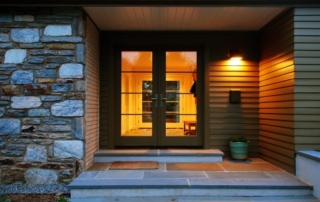OUR BLOG
OUR BLOG
Check out what’s happening with Myers Constructs as well as the latest news and trends in home renovation.
Fighting the Big Chill: Radiant Floor Heating
One of the most effective ways to make a cold space more comfortable during the Fall and Winter months is to install radiant floor heating. We have done this in many projects, including our current Fairmount whole-house renovation and this Flourtown rancher, where we converted a former breezeway into a warm, welcoming entryway. The wiring is installed on top of the subfloor, then covered over with floor leveler before the finished flooring is installed. The heat is controlled via a wall switch — requiring only about as much energy as an incandescent lightbulb. A very efficient way to warm cold feet! Image: Damon Landry
Summer Vacation Memories Inspire Fall Renovation Plans
Although we all feel sad to see the summer come to a close, we find that this is a great time to look back on your vacation memories and use them as inspiration for updating and beautifying your home for the fall. Perhaps you stayed in a delightful vacation home or a posh hotel room with details you wished you could replicate, or you simply experienced a lovely, relaxed vibe that you want to recreate now that summer is over. The good news? We believe there is no reason your home can't feel as nice as — or better than! — a luxurious vacation destination. A great place to start is examining outdoor spaces, including patios, grottos, and decks. Investing in upgrading these features can enhance your everyday quality of life and give you a great place to unwind, read a book, or enjoy a glass of wine at the[...]
Update: Historic Cupola Restoration
During the coming weeks, our crew will be making impressive headway on our Fairmount cupola restoration, including: installation of new wood decking removal of seven layers of roofing from old flat roof closure of the old chimney opening installation of a new flat rubber roof and skylight a senior expert copper craftsman will be called in to install the new copper roof historic reproduction windows for the openings are done and awaiting installation, but we are keeping them off site to protect from damage Stay tuned to our website and Facebook page for photos of our progress!
In the Works: Fairmount Project Color Reveal
This week, we are finally approaching the "fun stuff" on our Fairmount project! Our exterior painters are on site prepping for the elaborate Victorian-schemed painting work shown in this rendering created by our color consultant. Inside, the framing is ready for the new mechanicals to be installed. HVAC and electrical are going in now, and the plumbing rough-in is complete. Once these are inspected and approved, we can move on to insulation and drywall.
The Right Approach to Concrete Slabs
We spent part of last week laying the concrete slab foundation for our new Fairmount kitchen addition. As you can see from the images here, this process involves pouring concrete into a form and ensuring a level and sturdy base upon which to build. [nivoslider id="13682"] The pros of using concrete slabs are: they stay cool in summer, they are solid, and they are not terribly expensive. The cons? The condition of the ground below and around the slab is communicated through the concrete. That means they can get damp in any season, and they are very cold in the winter. When you work with slabs, you need to keep these facts in mind. Thankfully, modern construction methods have ways to deal with these downsides. For this project, we laid down a vapor barrier and more than 2 inches of foam insulation below the foundation. This will keep it isolated[...]
Remodeling Homes of a Certain Age
I recently ran across this article detailing the amazing restoration of the Frank Lloyd Wright-designed Boynton House in Rochester, NY. In the interview for PBS, homeowner Fran Cosentino said, "You wouldn't expect to drive a 100-year-old car on the road without a complete overhaul. The same is true for a 100-year-old house." This sentiment rings true for us every day. Homes of a certain age simply have complicated interrelated issues and problems. And sometimes, those problems have been covered up, their solutions put off for a very long time. The homeowners know that a proper fix will be a major undertaking, and they often just don't know where or when to start. You may already be following our progress on a beautiful 19th-century Italianate-style Fairmount-area house project. We were called in to restore a storm-damaged cupola bay and attend to a series of other complicated and interrelated projects throughout[...]
Fairmount Whole-House Project: The Week in Pictures
Our Fairmount project is a beehive of activity this week as we frame out the new laundry room, pour a new concrete kitchen floor, install a breakfast room window opening, and remove and replace historically correct insulated windows! [nivoslider slug="fairmount-project-week-in-pictures-slider"]
Your Home: Playing It Cool When Temperatures Rise
Older homes tend to get a bad rap for being energy inefficient, but the truth is, many older homes have built-in energy-saving systems that homeowners can use to their advantage, particularly at this time of year. The vast majority of older homes are built from stone or brick with thick walls that retain heat in the winter and cool in the summer by way of their mass. Often, these houses also have small windows on the third floor or attic that are meant not only to allow light into the house, but also to allow hot air out during the summer. Opening these small windows creates negative pressure inside the house, which then draws cool air from the basement, where temperatures hover between 60 and 70 degrees at this time of year. This cooling air convection, combined with the thermal mass of the brick or stone, means many of these[...]
Renovation Challenge: Flood Zone
We recently received a call from a homeowner in an area of metro Philadelphia that is a notorious flood zone. In fact, this property owner told us his Schuylkill River waterfront property has been flooded out three times during the past five years alone! This homeowner called us after learning that his insurance company was going to "total" his house unless he could find a way to renovate to flood-proof it. His goal is to be able to power wash the debris away after any future flooding and quickly get back to living. That kind of solution is common at the shore, where we see houses on pilings and with blow-out walls on the first floor. However, the following elements are at play here: This house is in a historic area, so The Philadelphia Historic Commission will need to approve the homeowner's plans. The home abuts neighboring houses, so engineering[...]
Home Gyms: Out of Sight, Out of Mind
When it comes to creating a home gym, we often face a design dilemma: Where do you put it so folks will use it? We tend to think that locating exercise space in a garage or basement is just ... meh. We often find that those musty storage areas are uninviting, and they don't motivate homeowners to want to use them. In our own home, we keep our workout gear in our den because we find it to be so much nicer and easier to use there. Of course, this means the equipment has to look good, or at least nice enough that it looks like a feature rather than an eyesore. We can usually accomplish this for our project homes, too; it just requires a little extra thought and planning. One client of ours, who is a business consultant and investor, has his equipment in his very large cherry-lined[...]








